Blessed Diana D’Andalo (ca. 1201-1236) — Interceding for the Brethren
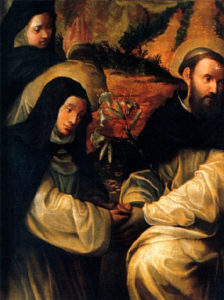 “Pray for me without ceasing to the Lord, both that He may always open out His Hand generously to us, and that He may send forth His Words from our lips unto His honor, the profit of the Church and the increase of the Order.” ~ Bl. Jordan of Saxony, 2nd Master of the Order
“Pray for me without ceasing to the Lord, both that He may always open out His Hand generously to us, and that He may send forth His Words from our lips unto His honor, the profit of the Church and the increase of the Order.” ~ Bl. Jordan of Saxony, 2nd Master of the Order
St. Dominic’s vision for the Order he founded is unique in that its mission rests upon the mutually dependent roles of both the friars and the nuns. From the days of St. Dominic to the present day, the relationship between the brethren and the nuns is manifested in mutual support, advice and guidance, study, friendship and, especially, in the sharing of spiritual goods for the up-building of the Order and the Church. The friendship between Bl. Diana and Bl. Jordan exemplifies the deep bond between the brethren and the nuns in Dominican spirituality.
Diana, a wealthy young woman of Bologna, was never one to do anything by halves. With the help of St. Dominic, she was able to found a monastery in Bologna, despite the opposition of her family. It was Bl. Jordan who assisted the fledgling monastery in every way, even transferring four nuns from San Sisto in Rome, who had made profession into the hands of St. Dominic, to Bologna to instruct the new foundation in the ways of the Order. Master Jordan visited this monastery frequently, and kept up an intense correspondence with Diana and her community; most of his letters curbing the excesses of the ever-zealous Diana. At her death, her community described her thus: “She was a great lover of the brethren and of the Order.”
Blessed Cecilia Cesarini (1203-1290) — Disciple of St. Dominic
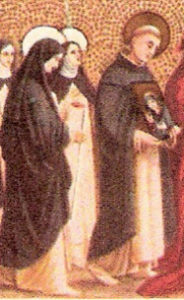 “Then our Lord…said to blessed Dominic, ‘I have entrusted your Order to my Mother.’” ~ Bl. Cecilia
“Then our Lord…said to blessed Dominic, ‘I have entrusted your Order to my Mother.’” ~ Bl. Cecilia
The silence of monastic life enlarges one’s capacity to listen. Through the faithful living out of regular observance a nun learns to listen, and becomes finely attuned to the slightest prompting of the Holy Spirit. Cecilia, of the ancient Roman Cesarini family, was an eager listener, quick to recognize the promptings of the Holy Spirit in her life. Her listening heart led her to meditate long and deeply on all she had seen and heard of our holy father Dominic. Monastic life in early 13th century Rome was quite lax, and it was the desire of Pope Innocent III to reform the Roman monasteries. However, it was his successor, Pope Honorius III, with the help of St. Dominic, who worked on the reform. The plan was to gather all the nuns of Rome into one monastery where their life could be regulated; the nuns, however, were resistant. Finally, the monastery of Santa Maria in Tempulo, of which 17 year old Cecilia was a member, agreed to come under the guidance of St. Dominic and move to the Church of San Sisto – provided that their icon of the Blessed Virgin would remain in San Sisto with them. (This icon had been known to return to its former location in other attempts at moving.)
Three times did the eager, young Cecilia make profession into the hands of St. Dominic. On arrival at the new monastery of San Sisto, she was the first to receive the Dominican habit from his hands, as he stood at the front door to welcome them. Two years later, in 1223, she was sent with three other nuns to the new monastery of St. Agnes in Bologna, “to teach them the Order.” She remained in this monastery until death. In old age, she dictated her memories of St. Dominic, leaving us not only a physical description of our founder, but also, through relating many of his miracles, a spiritual portrait of him as well – particularly his deep trust and confidence in God.
Saint Margaret of Hungary (1242-1270) — Love at First Sight
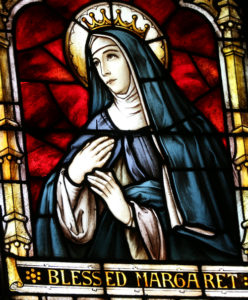 Margaret poured out her heart before Christ Jesus, hidden in the Eucharistic veil or depicted on the Cross. ~Pope Pius XII
Margaret poured out her heart before Christ Jesus, hidden in the Eucharistic veil or depicted on the Cross. ~Pope Pius XII
The penance and austerity so closely associated with monastic life characterized the brief but intense life of St. Margaret. As a princess – she was the daughter of King Bela IV of Hungary – she might have lived a comfortable “monastic” life; but instead she went out of her way to embrace all that was difficult, lowly and even repulsive. Her parents had vowed their child to God while she was still in the womb, and they placed her in a Dominican monastery at the age of three and a half. When Margaret requested and received the habit at age four, this was not mere child’s play. She had been shown a crucifix, and it was love at first sight; her heart was no longer her own. After two attempts to give Margaret in marriage to royal suitors, her parents understood that Margaret was not dutifully fulfilling their vow, but rather, that she was espoused to the King of kings. Her father then had another Dominican monastery built for her on an island in the Danube. By day, Margaret worked hard serving the community, especially the sick; by night, she kept vigil in prayer. Always, her heart and mind were fixed on Christ Crucified. She was often in ecstasy, and suffered the Passion. After a brief illness, St. Margaret died at the age of 28.
Saint Agnes of Montepulciano (1268-1317) — Contemplative Prayer
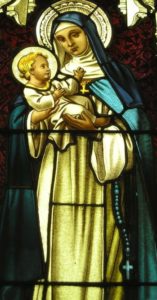 Agnes had that uncreated charity which continually burned and consumed her heart.
Agnes had that uncreated charity which continually burned and consumed her heart.
~ St. Catherine of Siena
From earliest childhood it became apparent that Agnes was richly endowed with the gift of contemplative prayer. At the age of nine, she entered a very austere Franciscan monastery in her home town of Monte Pulciano in Tuscany, Italy. She was sent on the foundation of a new monastery, and was elected abbess at the age of 15 ~ for which Rome granted a special dispensation. Miracles surrounded her, including showers of manna falling upon her, or the easing of the great poverty of her monastery in times of critical need. She was also favored with visions, including one in which our Lady placed the Christ Child in her arms. In another vision, she was requested to return to Monte Pulciano to found a Dominican monastery. This she did in 1306, purchasing a piece of land which had once been the site of a house of prostitution. She spent the last eleven years of her life here as a Dominican nun, in contemplative prayer. After a long illness with great physical suffering, which she embraced for the salvation of souls, she died in 1317.
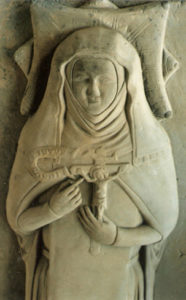 Blessed Margaret Ebner (ca. 1291-1351) — The Sweet Name of Jesus
Blessed Margaret Ebner (ca. 1291-1351) — The Sweet Name of Jesus
“Every cross I came upon I kissed ardently…. Such great desire and such sweet power so penetrated my heart and all my members that I could not withdraw myself from the cross.” ~ Blessed Margaret Ebner
The shadow of the Cross first fell upon Margaret and drew her to dwell in its sheltering arms, when at age 21 she suffered a long and grave illness. The spirituality of the young nun began to focus on the Cross and the love which Christ poured out for us upon it, and she grew in trust and surrender to God. In 1332, Margaret received the gift of the Name, “Jesus Christus”, which was poured into her or impressed upon her being to the extent that the Name of Jesus was constantly in her heart and on her lips. All graces came to her through this sweet Name, “Jesus Christus”, especially those which enabled her to understand and to experience the Passion. “My Truth, Jesus Christ, knows well that nothing in this world is sweeter or more delightful to me than the Name, “Jesus Christus”. With it I am lovingly compelled and pressed into the suffering of my dearly Beloved Jesus Christ.” The remaining 20 years of Margaret’s life were filled with mystical gifts and graces, and, much suffering, which she faithfully recounted in her Revelations. These gifts deepened her loving union with Christ, and overflowed in prayer for the salvation of souls.
Blessed Ana of the Angels (1602-1686) — Devotion to the Holy Souls
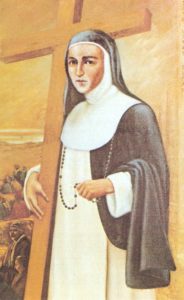 Sister Ana of the Angels carried out this program with an intense, austere, radical surrender to the monastic life, according to the manner of the Order of St. Dominic, in the contemplation of the mystery of Christ, the Truth and the Wisdom of God.
Sister Ana of the Angels carried out this program with an intense, austere, radical surrender to the monastic life, according to the manner of the Order of St. Dominic, in the contemplation of the mystery of Christ, the Truth and the Wisdom of God.
~ St. John Paul II
The radical surrender – or transformation in Christ – which monastic life entails, is worked out in a unique way in the life of each Dominican Nun. For Ana, of the noble Monteagudo family of Arequipa, Peru, the path to the Heart of Christ was the rugged one of persecution. She embarked on this path at the age of 14 when she resisted a well-arranged marriage, declaring that her heart belonged to Jesus, the Spouse of Virgins, and ran away from home to enter the Dominican monastery. Persecution remained her lot, now being carried out by the prioress and some of the nuns. Later elected as prioress, Ana began a radical reform of the monastery in order to curb the worldliness, individualism and disobedience in the community. Once again, she was plunged into persecution – even to the point of attempts being made on her life – by the strong resistance of the community.
To Blessed Ana’s deeply contemplative prayer were added two special gifts: prophecy and devotion to the souls in purgatory. Her prophetic gifts enabled her to pray intensely for those in sudden danger or special need. Her devotion to the Holy Souls led her to offer countless sacrifices and all of her sufferings for the souls in purgatory. She spent the last ten years of her life as a mystical prisoner for the Holy Souls who were most in need, enduring terrible physical pain and blindness. She remained serene, cheerful and overflowing with charity until the Spouse of Virgins came to claim His bride
Blessed Josefina Sauleda Paulis (1885-1936) — Unconditional Gift of Self
 Blessed Josefina’s spirituality was Christocentric and with aspiration for the gift of martyrdom. The Lord granted her desire to shed her blood to the last drop for her divine Spouse. ~ Sor Catalina Febrer, OP
Blessed Josefina’s spirituality was Christocentric and with aspiration for the gift of martyrdom. The Lord granted her desire to shed her blood to the last drop for her divine Spouse. ~ Sor Catalina Febrer, OP
Martyrdom — that coveted crown — is the complete and unconditional gift of oneself to God. It is granted to but few of those who yearn for it. St. Dominic himself longed intensely for the gift of martyrdom; perhaps in this way winning the grace of martyrdom for so many of his sons and daughters throughout the centuries. Blessed Josefina Sauleda Paulis received this crown at the age of 51, during the Spanish Civil War. Born in Barcelona in 1885, she knew at age 16 that the Lord was calling her to religious life. Initially drawn toward an active life of caring for the sick, she discerned that her vocation was to Dominican contemplative life, and entered the monastery of Montesion in Barcelona. She served the community in many capacities, including prioress and novice mistress.
On 19 July 1936 the nuns had to flee their monastery to seek refuge elsewhere. Although Sr. Josefina could easily have hidden in her hometown, she chose to remain with the community, and took charge of them in their exile. She was captured on the morning of 31 August and was tortured for 12 hours. Despite the severity of the torture, she refused to reveal where the other nuns and the chaplain were hiding. She finished her contest in the hippodrome, where her unrecognizable body was found the following day. She was beatified by Pope Benedict XVI in October 2007, and is the first Dominican Nun to be beatified as a virgin-martyr.
